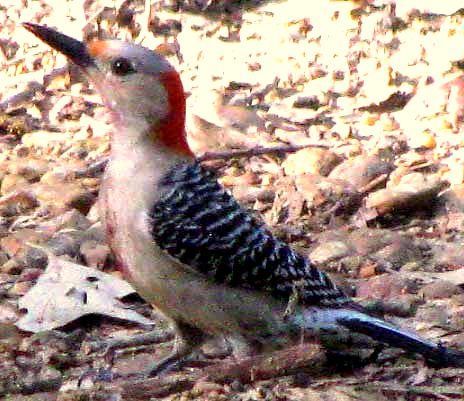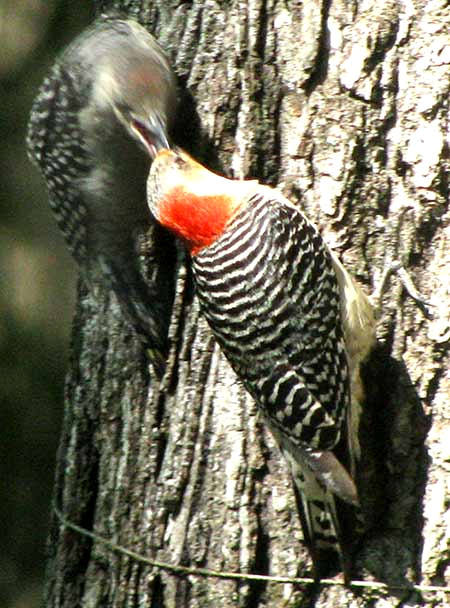Excerpts from Jim Conrad's
Naturalist Newsletter
from the May 6, 2012 Newsletter issued from the woods of the Loess Hill Region a few miles east of Natchez, Mississippi, USA
RED-BELLIED WOODPECKER

Above you see what in most of the eastern US is the commonest, most frequently noticed woodpecker species, the Red-bellied Woodpecker, MELANERPES CAROLINUS. That one landed on Karen's driveway and hopped around in spite of the proximity of the house and there being cats, dogs and people about. You just have to admire the species' verve and flexibility. They do peck on tree trunks and eat regular woodpecker fare, but also you see them gorging on tree fruits, snapping insects out of the air, and sometimes even capturing small lizards and birds. Currently Red-bellies are expanding their distribution to the north and west.
The name "Red-bellied" usually confuses beginning birders because typically the belly isn't all that red. The one in the picture has a belly with a little red flush, but outside the breeding season often there's no red on the belly at all.
If this Mississippi bird were to appear in the Yucatan I'm not sure I'd notice the difference between it and the similarly aggressive, fruit-eating, sometimes-red-bellied Golden-fronted Woodpecker, which is the most common woodpecker there. You might enjoy comparing the above picture with that of a Golden-fronted at http://www.backyardnature.net/yucatan/wp-g-f.htm.
The Golden-fronted's zebra stripes are a little narrower than our Red-bellied's, but that's not much difference. Maybe someday the two species will be lumped into one big, polymorphic one.
from the May 13, 2012 Newsletter issued from the woods of the Loess Hill Region a few miles east of Natchez, Mississippi, USA You know it's the mother because her red is limited to the back of her head, the nape; on males the redness continues well onto the crown. The picture also answers the question of whether the adult jams its beak into the fledgling's open mouth, or the fledgling rushes to accept what's in the adult's beak. You can see that the mother is in focus but the fledgling is blurred by motion, so it's the fledgling who, at least this time, controlled the entry of the adult's beak into its own.
HUNGRY FLEDGLING
On a big Black Oak trunk near the trailer a fledgling Red-bellied Woodpecker waited nonchalantly doing nothing, so I figured an adult wood soon appear with food, and readied the camera. At the very moment the lens focused on the lolling kid, mama darted into the viewfinder, resulting in the picture below:
from the March 14, 2004 Newsletter issued from the woods of the Loess Hill Region a few miles east of Natchez, Mississippi, USA
WOODPECKER MEETS FLYING SQUIRREL
Near the woodland pond a Red-bellied Woodpecker was pecking at something inside a hole in a dead snag about 30 feet up a Water Oak. I thought he might be cleaning out the hole to make a nest, but he wasn't removing debris so I couldn't figure out what he was doing. And then it became clear.
Suddenly his wings flashed and he jumped back as a Southern Flying Squirrel, GLAUCOMYS VOLANS, shot from the hole and scrambled down the trunk with the quickness of a mouse streaking across a floor. He moved so fast that I hardly saw more than his size and color, and a goodly amount of loose skin rippling along his sides.
Within a second or two the squirrel had disappeared. The woodpecker hung around for a minute or two and then flew off not to return while I was watching. My impression was that getting the squirrel out of the hole had been his whole mission, and I can only guess that he simply didn't want any potential woodpecker nesting hole in his home range claimed by anyone, whether another woodpecker or a rodent.
Because Flying squirrels are nocturnal, I never see them unless one of them has bad luck. In towns, cats often bring them in. At my previous location they lived inside the walls of an old building, and at night orchestrated a wonderful noise. The people there occasionally managed to trap one, but always others remained to thump and scrape all through the night. Here on summer nights I often hear sounds in the trees which I suppose to be made by them, especially when it's acorn-eating time.
from the September 15, 2002 Newsletter issued from the woods of the Loess Hill Region a few miles south of Natchez, Mississippi; elevation ~200ft (~60m), ~N31.42°, ~W91.41°; USA
RED-BELLIED WOODPECKERS
Now that the mosquitoes have calmed down I've returned to my old habit of late each afternoon biking over to the hunters' camp, sitting on their porch, and reading. One day this week while absorbed in To Kill a Mockingbird I heard a racket in the Pecan tree above me and looked up just in time to see two Red-bellied Woodpeckers all in a wad, each with a bit of the other in its beak, clawing and beating wings against one another. They tumbled 20 feet, thudded onto the ground next to me, and I thought that surely they'd both be crippled.
But they just fought a little longer, then one flew off horizontally and the other vertically. I guess the one who went vertically was the winner.
Both in my home area in Kentucky and here, in upland situations Red-bellied Woodpeckers are the most common woodpecker species, and for that reason alone usually I don't get too excited about seeing one. However, over the years I've experienced a sort of creeping admiration for the species.
First of all, when I began traveling in the American tropics I came to realize that our Red-bellied species was just the local expression of a complex of very similar species distributed all the way into South America. In northern Mexico's mesquite plains the Golden-fronted Woodpecker is everyplace, and looks and sounds almost like our Red-bellied, just a little rangier. In pine forests farther south the Golden-cheeked Woodpecker looks almost the same, but with black spectacles. The Yucatan Woodpecker also looks almost the same, but it's a pygmy version. And on it goes. What a pleasure to behold variations on a theme you grew up with, thinking that that theme could be sung only one way.
Once this spring as I lay atop my trailer one Saturday morning listening to the radio a Red-bellied was excavating his nest in a Pecan tree's nearly horizontal limb about 30 feet above me. His hole entered from the limb's bottom surface so as he dug inside the limb sawdust tumbled through the hole in his floor behind him and rained onto my camp. About every minute he'd poke his head from this hole with his beak so wide open that you could see his long tongue as he gasped for breath. Well, if you're inside a limb chipping at wood, there are no windows, your body is blocking air coming into the hole behind you, so it must get awfully stuffy.
He looked funny the way his head poked from the bottom of that limb, with his beak wide open and his tongue lolling all around. But instead of laughing I was struck with the realization that here was just another regular good schnook doing his best at a rough job. He was like all of us facing tasks that leave us a bit washed-out and silly feeling. Nowadays when I'm almost feeling sorry for myself after computering all day, my back muscles burning, and I'm a bit groggy, I just remember that fellow with his tongue hanging out.